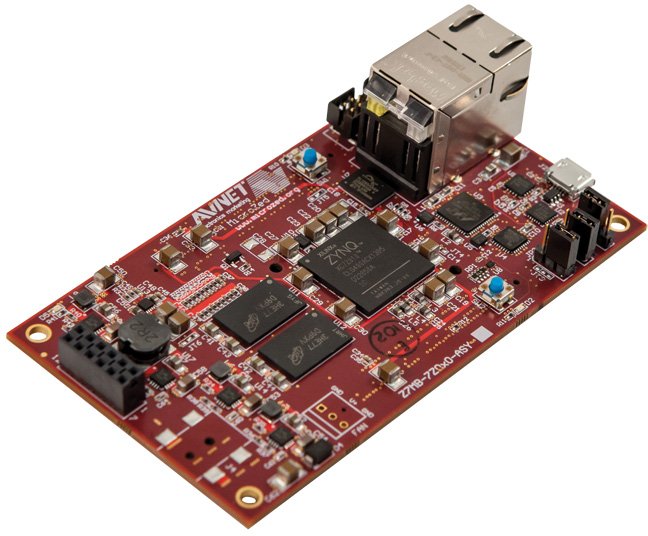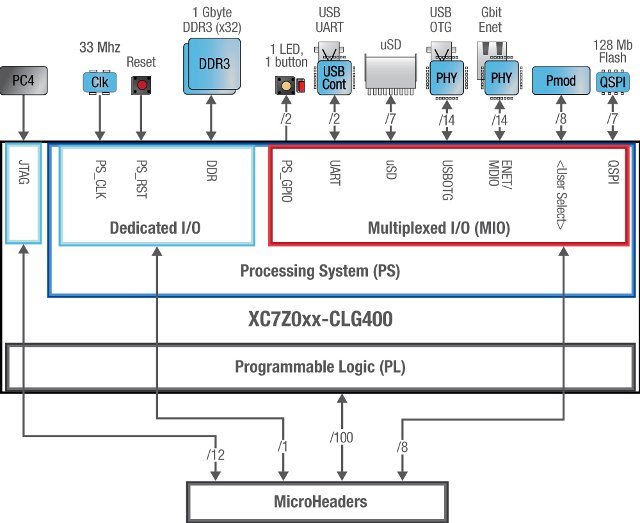ZedBoard is a low cost development board based on Xilinx Zynq-7020 SoC featuring two Cortex A9 cores and FPGA fabric, together with lots of ports and expansion I/Os, and running Linux. The problem is that “low cost” for this type of board still means $395 (or around $300 for academia), and you only get to this price because it’s been subsidized, and the normal price is actually $495… That’s why Avnet has just come with a new version of the evaluation kit called microZed that sells for $199 and targets applications such as general Zynq-7000 AP SoC evaluation and prototyping, embedded system-on-module (SOM) applications, embedded vision, test & measurement, motor control and software-defined radio.
 MicroZed technical specifications:
MicroZed technical specifications:
- SoC – Xilinx XC7Z010-1CLG400C (Zynq-7010)
- System Memory – 1 GB of DDR3 SDRAM
- Storage – 128 Mb of QSPI Flash + Micro SD card interface
- Connectivity
- 10/100/1000M Ethernet
- USB 2.0
- USB-UART
- User I/O (via dual board-to-board connectors) – 100 User I/O (50 per connector) configurable as up to 48 LVDS pairs or 100 single-ended I/O
- Misc
- 2×6 Digilent Pmod compatible interface providing 8 PS MIO connections for user I/O
- Xilinx PC4 JTAG configuration port
- PS JTAG pins accessible via Pmod
- 33.33 MHz oscillator
- User LED and push switch
- Power – 5V (USB UART) or 5V/12V (barrel jack or micro- header) AC/DC supply
- Dimensions –
The evaluation kit comes with the MicroZed board, a micro USB cable, a 4GB μSD card, Xilinx Vivado WebPACK license with Logic Analyzer (device locked), and a Getting Started card. The community provides full documentation including a getting started guide, hardware guides, schematics, bill of materials, PCB layout, and mechanical files. There are also a few training videos for both microZed in particular, and Xilinx Zynq in general. Strangely, I’m struggling to find details about Linux on the platform.
Let’s have a quick look at the difference with the Zedboard, and how they managed to cut costs. The main difference is whereas Zedboard is based on Zynq-7020, MicroZed is powered by Zynq-7010. The latter offers 28K logic cells, against the former 85K logic cells. Zynq-7010 has also about a third of Zynq-7020′s look-up tables (17,600 LUTs), extensible block RAM (240KB), programmable DSP slices (80), peak DSP performance (100 GMACs), and flip-flops (35,200). MicroZed has 1GB RAM instead of 512MB on Zedboard, so no cost cutting here, I presume. QSPI flash is smaller (128MB vs 256 MB), and MicroZed goes without many of the video and audio interfaces found in Zedboard.
As I mentioned previously, MicroZed evaluation kit costs $199 on Avnet, but the board can also be used like a system-on-modules on be bought for $192 (Zynq-7010 version) or $289 (Zynq-7020 version).
Via LinuxGizmos

Jean-Luc started CNX Software in 2010 as a part-time endeavor, before quitting his job as a software engineering manager, and starting to write daily news, and reviews full time later in 2011.
Support CNX Software! Donate via cryptocurrencies, become a Patron on Patreon, or purchase goods on Amazon or Aliexpress





